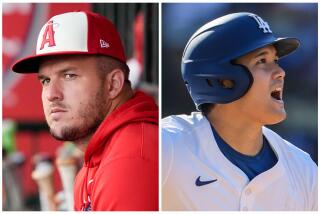ALL TOGETHER NOW : Another Tradition Bites the Dust as Interleague Play Begins Today
- Share via
If this is Thursday, the 12th of June, those must be the San Diego Padres in Anaheim to play the Angels and those must be the Dodgers flying to Oakland to tackle the Athletics and those must be the San Francisco Giants in Texas to meet the Rangers.
If this is Thursday, the 12th of June, that must be the Brotherhood of Baseball Purists observing a day of mourning as the sport discards decades of tradition and begins a two-year experiment in interleague play as an economic and marketing stimulant.
Said acting Commissioner Bud Selig: “I think the only legitimate question is, why did it take so long? What was baseball waiting for?
“In my mind, it will be much bigger than anyone has predicted and a permanent part of the baseball landscape.
“It’s already attracted a lot of attention and conversation at a time when the game needs it.”
Said Padre President Larry Lucchino: “The fact alone that it’s new and a departure reflects positively on the well-being of the sport.
“People may argue that it’s economic desperation, but it’s not. I mean, how many times has baseball been accused of being slow to change and innovate? I think this is a positive response.”
Purists, however, contend that even a limited interleague schedule will detract from the World Series and integrity of the American and National leagues.
They argue that it will underscore the absurd dichotomy in the use of the designated hitter and create a scheduling imbalance that affects the pennant and wild-card races. They say it has already generated havoc with the 1997 schedule, creating an array of two-game series that has left jet-lagged players feeling as if “we’re moving through time zones like Buck Rogers,” as Dodger reliever Todd Worrell noted recently.
However, Seattle Mariner Manager Lou Piniella dismisses the purity argument.
“If baseball is such a traditional sport,” he said, “why aren’t the strike zones similar in both leagues and why isn’t the DH used in both or not at all?
“Why aren’t the dimensions uniform and why don’t we play on grass or artificial surface, but not both? Baseball is probably the most impure of all sports, and that adds to the popularity.
“People say interleague will detract from the World Series [because the teams may have played during the regular season], but that hasn’t hurt the Super Bowl or the NBA and NHL championships. If anything, it’s produced new rivalries and matchups that have added to the intensity of the championships. I like it. I think it will be good for the fans and the game.”
Not everyone is as emphatic and supportive as Piniella.
“I don’t like it,” Florida Marlin Manager Jim Leyland said. “I’m from the old school. I’ve always felt that the thing that separates baseball from the other sports is that we played the World Series between teams that hadn’t played [during the regular season]. However, if baseball thinks this will help the economics, God bless ‘em. If this is what the fans want, then this is what we should give them. The paying customer is the most important factor.”
Attendance dropped about 19% during the players’ strike in 1994. It was up about 6.7% last season and has been up an additional 4.5% this year, producing a per-game average of almost 26,000. Advance sales for the first round of interleague games, which runs through Wednesday, indicate that average should increase 32% to 40%
“Look, the main reason we’re in business is to draw customers,” said Stan Kasten, president of the Atlanta Braves. “If there were no customers, no one would be playing in empty stadiums for the purity of the game. We exist so that the most people possible can watch us, and we’re now going to display our greatest stars in cities where, for the most part, they’ve never played.
“My guess is that it will be a huge success, which doesn’t mean every game will be a knockout, just like every game in seasons prior to interleague wasn’t a knockout.
“I just feel there’s enough interesting and different scenarios to keep fans excited.”
Not in Anaheim, perhaps. The Angels, barring a major walk-up, expect only 17,000 for tonight’s interleague opener against Tony Gwynn and the Padres in Anaheim Stadium and have sold only about 20,000 tickets for each of two games against the Dodgers on July 2-3.
The Dodgers expect close to 40,000 for each of two games against the Angels at Dodger Stadium on Tuesday and Wednesday.
For every neighborhood war such as the Dodgers-Angels, Cubs-White Sox, Yankees-Mets, for every possible World Series preview such as the Baltimore Orioles meeting the Atlanta Braves or every interesting matchup such as Dodger pitchers trying to tame the powerful Mariner hitters in a sold-out Kingdome this weekend, there’s a Minnesota-Houston or a Pittsburgh-Kansas City dud.
“You can’t generalize,” the Padres’ Lucchino said. “You can’t say there’s going to be rampant excitement across the board, but some series will definitely be off the charts.”
The Padres, for example, expect to draw 40,000 per game for what they are calling the Five Days of Summer, beginning July 2. They play two against Ken Griffey Jr. and the Mariners, then three against the Dodgers--”those odious, dreaded Dodgers or, as they are known here, the cheating Dodgers,” Lucchino said, referring to Wilton Guerrero’s corked bat.
In all, each team in the East and Central divisions will play a total of 15 games against East and Central teams of the other league, while each team in the West will play a total of 16 games with their Western counterparts. Each of the Western teams play eight games at home and eight on the road. However, there is no such uniformity in the East or Central, where a team either plays nine games on the road and six at home, or vice versa.
This imbalance is what creates consternation for some, particularly as it applies to the wild-card race, where teams from different divisions compete for the same prize but will do so now playing different schedules under different rules. Since the designated hitter will be used only in American League parks, as it is in the World Series, AL teams competing for the wild card from different divisions will be forced to give up their designated hitter a differing number of times.
Purists will also argue that AL teams, in general, will be at a disadvantage in NL parks, where they will be forced to bat pitchers who are unaccustomed to hitting.
AL teams have won six of 10 World Series played under current designated hitter rules, but could they have won more if the designated hitter was used in all games rather than only those played in AL parks? Would they have won fewer if the designated hitter wasn’t used at all?
“I’m definitely for interleague play,” Texas Manager Johnny Oates said. “I think the idea is great, but playing by different sets of rules is ridiculous.
“The NFL, NHL and NBA all play interleague or interconference, but they play by the same rules. We don’t--and it could cost us.”
Perhaps, but Angel Manager Terry Collins, calling himself a traditionalist who believes that interleague play is a needed elixir, said “the season is so long that it all evens out,” and his shortstop, Gary DiSarcina, added, “we may be at a disadvantage using a pitcher to hit [in half of the interleague games], but I don’t think those 16 games will change the fact that the best team almost always wins a 162-game schedule.”
Collins is one of five AL managers with National League experience and said he doesn’t expect trouble operating again with double switches and pinch-hitters--scenarios most frequently found in NL games.
“There’s not too many players in the NL I don’t know,” he said, a familiarity that could prove valuable.
In general, teams have incorporated a second or third advance scout to prepare reports on their interleague opponents, possibly generating the spinoff of increased trade avenues through increased familiarity, Dodger vice president Fred Claire said, adding, “I’m more of a traditionalist who at one time would have said, ‘why do we need [interleague play],’ but I now think it’s the right time to reach out and try it.”
Interleague play has been on and off the owners’ agenda for years.
Selig was a member of a two-man committee that mustered sufficient AL support in 1970 but failed in the haughty NL.
Innovative executives such as Bill Veeck, Charlie Finley and Frank Lane frequently pleaded for interleague acceptance--”Why should any club snub anything which means progress, fresh interest, more talk about baseball?” Veeck said in 1959--but were unable to convince enough colleagues.
The current experiment is viewed as a prelude to major realignment in 1999.
“My view is that interleague play should have happened 50 years ago,” Mariner Chairman John Ellis said. “It wouldn’t hurt my feelings a bit if we did away with the leagues and reorganized geographically. I believe we need regional rivalries from the standpoint of economics and attendance.”
Isolated in the Pacific Northwest, the Mariners have felt the brunt of the convoluted schedule this year. They have 28 two-game series compared to seven last year. Both management and the players’ union--which has approved interleague play for 1998 but still must approve the schedule--agree that changes are needed. The addition of Tampa Bay and Arizona is expected to produce fewer two-game series but also may result in some teams playing one less home and road series against some teams in their own league.
“When you incorporate interleague and add teams and play the same number of games in the same number of weeks, something has to give,” said Katy Feeney, the National League vice president.
If the interleague schedule is expanded to 24 games per team next year--which is not expected--management and the union have agreed to employ the designated hitter in all of those games. The prevalent view, however, is that 15 or 16 games is enough.
“I think everyone believes the integrity of the leagues is important and that interleague play should remain limited,” said Larry Baer, Giant vice president. “Give fans a taste, but save the real competition between leagues for the World Series.”
A taste?
“It’s kind of like anchovy pizza,” Lucchino said. “I like a little bit once in a while, but not as a steady diet.”
(BEGIN TEXT OF INFOBOX / INFOGRAPHIC)
Interleague Play at a Glance
* TODAY: Dodgers at Oakland, 7 p.m.; San Diego at Angels, 7 p.m.; San Francisco at Texas, 5:30 p.m.; Colorado at Seattle, 7 p.m.
* SCHEDULE: All interleague games will be played during three periods--today through June 18, June 30-July 3 and Aug. 28-Sept. 3.
* GAMES: Teams in East and Central divisions each will play 15 interleague games. West clubs will play 16.
* FORMAT: It will be AL East vs. NL East, AL Central vs. NL Central and AL West vs. NL West. Each East and Central team will play three games against every team in the corresponding division; West teams will face each other four times, with two games in each city.
More to Read
Go beyond the scoreboard
Get the latest on L.A.'s teams in the daily Sports Report newsletter.
You may occasionally receive promotional content from the Los Angeles Times.










